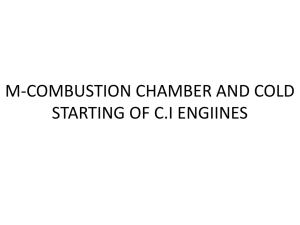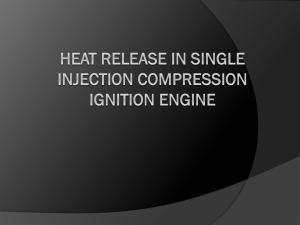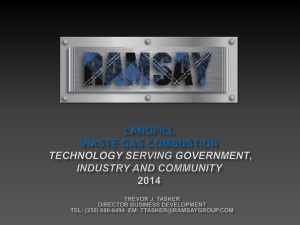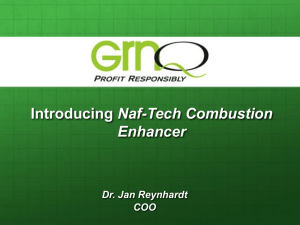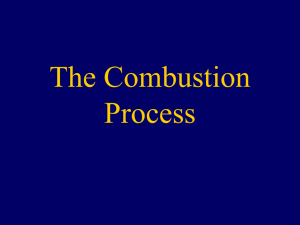ImplementationAdvancedFuels
advertisement
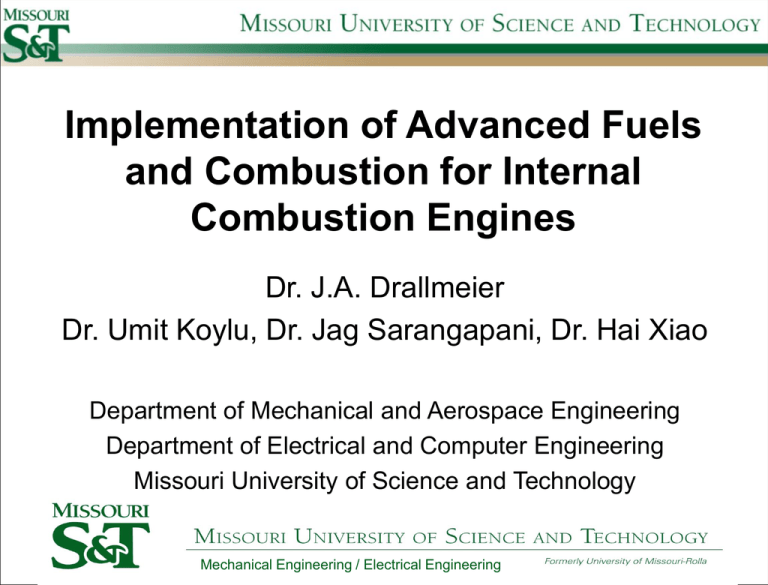
Implementation of Advanced Fuels and Combustion for Internal Combustion Engines Dr. J.A. Drallmeier Dr. Umit Koylu, Dr. Jag Sarangapani, Dr. Hai Xiao Department of Mechanical and Aerospace Engineering Department of Electrical and Computer Engineering Missouri University of Science and Technology Mechanical Engineering / Electrical Engineering Overview • Nature of Advanced Combustion Modes in Reciprocating Internal Combustion Engines • Fuel Flexibility of Advanced Combustion Modes • Advanced Cyclic Feedback Control • Sensors for Cyclic Control • Advanced Engine Simulations for HydrogenFueled Engines • Future Directions Mechanical Engineering / Electrical Engineering Advanced Combustion Modes • SI - Low cost while meeting current emission regulations. • CI (“Diesel”) - 30 to 40% higher thermal efficiency than SI but NOx and soot emission control issues. • Low Temperature Combustion (LTC) – Low NOx, negligible soot with high thermal efficiency. Mechanical Engineering / Electrical Engineering Advanced Combustion Modes Advantages of advanced LTC modes: • Short duration combustion leading to higher thermal efficiencies. • Homogeneous charge prevents rich regions and hence soot formation. • Lower combustion temperatures (lean) which reduces NOx formation. • Achievable with a wide variety of fuels. Mechanical Engineering / Electrical Engineering Advanced Combustion Modes Challenges facing implementation of advanced LTC modes: • Mixture preparation • High pressure rise rates leading to noise and limiting full-load capabilities • Control of start-of-combustion (kinetically controlled) o Variation with fuels o Variation between cycles Mechanical Engineering / Electrical Engineering Advanced Combustion Modes – HCCI (Massey and Drallmeier – ORNL) • Single cylinder Hatz engine configured for HCCI combustion Objectives of Work – Benchmark a small single cylinder engine for HCCI studies. – Identify the viability of surface acceleration for closed-loop combustion control. Mechanical Engineering / Electrical Engineering Advanced Combustion Modes - HCCI Impact of fuel type on start-of-combustion (SOC) Energy Release Rate (J/deg) • SOC is controlled by chemical kinetics (not spark or injection timing) • Inlet temperature and fuel type dramatically impact SOC 95 • Combustion phasing and duration impact “efficiency” • HCCI is very fuel flexible if combustion phasing and duration can be controlled. TRF, Ti = 190C TRF, Ti = 180C 75 55 35 E85, Ti = 190C E85, Ti = 180C 0.93 ms UG, Ti = 190C UG, Ti = 180C Conventional 15 -5 330 340 350 360 370 380 390 Crank Angle Degree Mechanical Engineering / Electrical Engineering Advanced Combustion Modes - HCCI Impact of SOC and duration on efficiency • Single fuel with varied inlet temperature • CE – Combustion efficiency; TE – Thermal efficiency CE=97% TE=34% CE=92% TE=34% Energy Release Rate (J/deg) 95 75 Ti = 200C Ti = 190C CE=94% TE=36% 0.93 ms 55 Ti = 185C Ti = 180C • However, phasing relative to TDC is critical 35 CE=81% TE=32% 15 -5 330 340 350 360 370 • Shorter duration tends toward better efficiency (Otto cycle) 380 390 Crank Angle Degree Mechanical Engineering / Electrical Engineering Advanced Combustion Modes Summary • Advanced combustion modes (LTC) provide a path to increased fuel efficiency simultaneous with reduced emissions and fuel flexibility. • One critical need to implement these modes is advanced control schemes as chemical kinetics control combustion phasing and fuel sources and composition (bio-fuels, petroleum based, blends, etc.) can vary widely. • Control needs to nearly cyclic to minimized output fluctuations and adjust for varying input conditions (fuel, temperature, etc.) Mechanical Engineering / Electrical Engineering Advanced Nonlinear Adaptive Cyclic Control (Sarangapani and Drallmeier – NSF) • Engine dynamics expressed as nonstrict feedback nonlinear discrete-time systems x1 k 1 AF k F k x1 k R F k CE k x2 k d1 k x2 k 1 1 CE k F k x2 k MF k u k d2 k Neural Network (NN) Controller yk x 2 k CE k VT x1 (.) 1 2 3 (.) CEk CEmax ( k ) m u l 1 100 x k k R 2 x1 k x2 Engine WT (.) y1 (.) y2 (.) ym (.) xn Inputs (.) L outputs Hidden Layer Control Inputs Measurements NN Observer • Engine dynamics are not • Control design requires an accurately known before hand; observer to estimate total fuel and adaptive neural networks are air utilized to approximate the unknown dynamics Mechanical Engineering / Electrical Engineering Advanced Nonlinear Adaptive Cyclic Control Engine Controller Timing Specifications 5 intake valve closed start of combustion 4 3 2 SOC exhaust valve open example pressure TDC intake valve open begin fuel injection TDC 1 0 0 100 200 300 400 500 600 700 degrees Engine Sim at 1000 RPM 5 • Controller developed for lean and high EGR SI engine. • Control was performed by microprocessor based system driving small perturbations on the fuel injector pulse width. Time series of Heat Release for Equivalence Ratio Set Point = 0.77 4 pressure 24.167 ms 3 1200 1100 2 fuel injection 17.667 ms 1000 18.167 ms 1 0 0 0.02 0.04 0.06 time (seconds) 0.08 0.1 0.12 Heat Release(k), J calculation 900 800 700 600 500 400 300 -500 -400 -300 -200 -100 0 k th cycle Mechanical Engineering / Electrical Engineering 100 200 300 400 500 Advanced Nonlinear Adaptive Cyclic Control 0.04 0.04 0.035 0.035 0.03 0.03 0.025 0.02 0.025 0.02 0.015 0.015 0.01 0.01 0.005 0.005 0 0 0 0.01 0.02 HR(k) 0.03 0.04 Uncontrolled HR: =0.97 - COV: 0.1873 HR(k+1) Misfire HR(k+1) HR(k+1) Controlled =0.76 0.045 0 0.01 0.02 HR(k) 0.03 Heat Release for Lean Operation Without (left) and With (right) Control 0.04 Controlled HR: =0.97+3.4% - COV: 0.0838 1200 1200 1100 1100 1000 1000 900 900 HR(k+1) Uncontrolled =0.76 0.045 800 700 800 700 600 600 500 500 400 400 300 300 400 600 800 HR(k) 1000 1200 400 600 800 HR(k) 1000 Heat Release with 10% EGR Without (left) and With (right) Control • Adaptive critic neural network controller for lean and high EGR engine operation on two engine reduced NOx by around 90%, unburned hydrocarbons by 30%, and CO by 10% from stoichiometric levels. • Fuel efficiency is enhanced by 8% from current levels. • Misfires have been minimized Mechanical Engineering / Electrical Engineering 1200 Sensors for Cyclic Control These control schemes require advanced, robust, low-cost sensors for feedback: Vibration Based Sensors: (Massey and Drallmeier – ORNL) • Identify frequency bands that carry information regarding the combustion process with minimal structural influence. • Increase understanding of dynamic fluidstructure interactions within the engine combustion chamber. • Identify the viability of surface acceleration for closed-loop combustion control. Mechanical Engineering / Electrical Engineering Spectral Power (g2) 1 – 4kHz (band) Pressure (bar) Crank Angle 1. Load FEA Model with Measured Cylinder Pressure 40 -Y- Direction 30 Ti = 202C Ti = 192C Ti = 182C 20 10 0 0 35 70 105 140 Acceleration (g) Peak Heat Release Rate (J/deg) Time (s) 3. Extract Structural Modes Power Spectral Density 2. Compare Measured and Computed Accelerations 4. Investigate Correlation Between Cyclic Combustion and Frequency Band Acceleration Characteristics Structure Mode Frequency (kHz) Mechanical Engineering / Electrical Engineering Sensors for Cyclic Control Microphotonic Devices (Xiao – DoE) • Devices under investigations – – – – Fabry-Perot interferometer Long period fiber grating Microresonators Tunneling device • The differentiators of our devices – Ultracompactness, robustness, dependable performance Mechanical Engineering / Electrical Engineering Extrinsic Fabry-Perot Interferometers Capillary tube Fiber Diaphragm Holly Fiber Ferrule Expanded signal trace 0.6 Partial discharges in an electric transformer Output in volts 0.4 0.2 0 -0.2 -0.4 -0.6 0 Mechanical Engineering / Electrical Engineering 20 40 60 80 100 120 Time in us 140 160 Acoustic Sensor 180 200 Micro inline Fabry-Perot Interferometers Miniaturized inline Fabry-Perot interferometer (FPI) fabricated by one-step femtosecond laser micromachining • Linear response • Extremely small T-dependence • No drift issue! L (a) I1 30.88 Core I2 Cavity Length (m m) 30.87 Cladding 30.86 30.85 (b) 30.84 30.83 30.82 Slope = 0.074pm/C 30.81 30.80 30.79 0 200 400 600 800 1000 1200 Temperature (C) Mechanical Engineering / Electrical Engineering (c) Hydrogen Engine Simulations (Koylu - National University Transportation Center) Hydrogen Fuel is being considered as an engine fuel due to its unique properties using advanced simulations Characteristic Higher efficiency due to higher flame speed leading to faster combustion Lower emissions due to non-carbon fuel content, only NOx at higher loads/equivalence ratios Hydrogen Gasoline Notes Heating value (kJ/g) 120 44.5 higher heating value Flame speed (m/s) 2.1 0.3 faster burning Flammability limits (vol%) 4-74 1-7 wider limits Ignition energy in air (mJ) 0.02 0.3 easier ignition • Wide flammability limits decrease cycle by cycle variations. • Ignition of hydrogen mixture possible with a relatively weak spark. • Hydrogen can be mixed with other fuels (methane, biogas, diesel) to improve their combustion and emission characteristics. Mechanical Engineering / Electrical Engineering Hydrogen Engine Simulations Computational Modeling of a Hydrogen Engine using GT - Power 8 8000 Simulations Experiments Simulations Experiments 7000 6000 6 NOx (ppm) Brake Power (kW) 7 5 4 3 5000 4000 3000 2 2000 1 1000 0 0 0 0.2 0.4 0.6 0.8 1 1.2 0 1 Equivalence Ratio Mechanical Engineering / Electrical Engineering 2 3 4 5 Brake Power (kW) 6 7 8 Future Directions Ongoing initiatives of the Investigators: • Develop novel control scheme capable of using an adaptive feedback control strategy to maintain proper phasing of combustion as well as heat release rise rates for LTC modes. • Implement advanced combustion modes in a fuel-flexible sense where the fuel is not known a-priori by sensing heat release and adjusting combustion system parameters online. • Identify novel sensor techniques which would provide sufficient cyclic information for a nonlinear adaptive controller. • Extend advanced engine simulations for developing hydrogen fuel strategies. • Develop models for hydrogen fuel-specific combustion flame speed and NOx emission. Mechanical Engineering / Electrical Engineering

